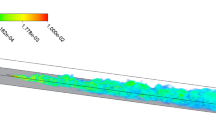Abstract
For olfaction to occur, signal molecules must move through the environment from the source to the receptor cells. As molecules approach receptor structures they pass through a boundary layer surrounding those receptor structures. Within boundary layers the interaction between the forces causing chemical dispersion changes. To investigate how the boundary layer changes the dynamics of the chemical signals, we measured chemical dynamics within the boundary layer around the moth antennae using microelectrodes. The results showed that the boundary layer amplified three aspects of the chemical signal: peak height, peak onset, and decay time. Spectral analysis of turbulent signals showed that the temporal aspects of the chemical signal were altered. The boundary layers around the male and female antennae have different effects on the spectrum of chemical temporal fluctuations. Specifically, at a flow speed of 0.12 m s−1, the analysis showed distinct amplification patterns for each sex. Thus, the fluid flow around the antennae functions as a filter, altering the structure of the chemical signal that is arriving at the receptors. The results illustrated in this study show that male and female moths have different physical filters that can alter the information that can be extracted from odor plumes.
Similar content being viewed by others
Author information
Authors and Affiliations
Additional information
Accepted: 1 September 1997
Rights and permissions
About this article
Cite this article
Schneider, R., Lanzen, J. & Moore, P. Boundary-layer effect on chemical signal movement near the antennae of the sphinx moth, Manduca sexta : temporal filters for olfaction. J Comp Physiol A 182, 287–298 (1998). https://doi.org/10.1007/s003590050179
Issue Date:
DOI: https://doi.org/10.1007/s003590050179




